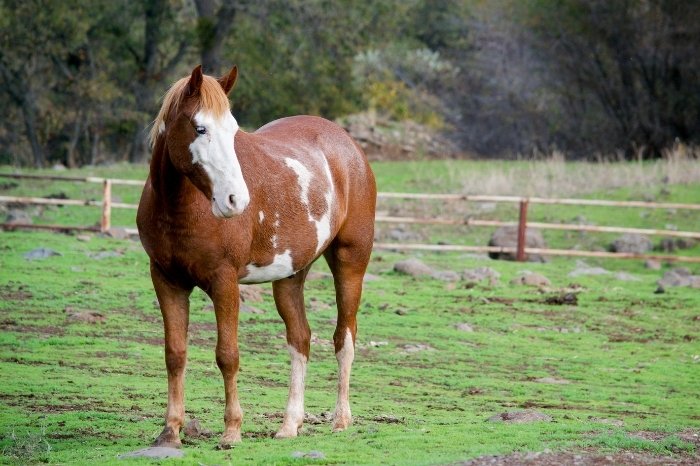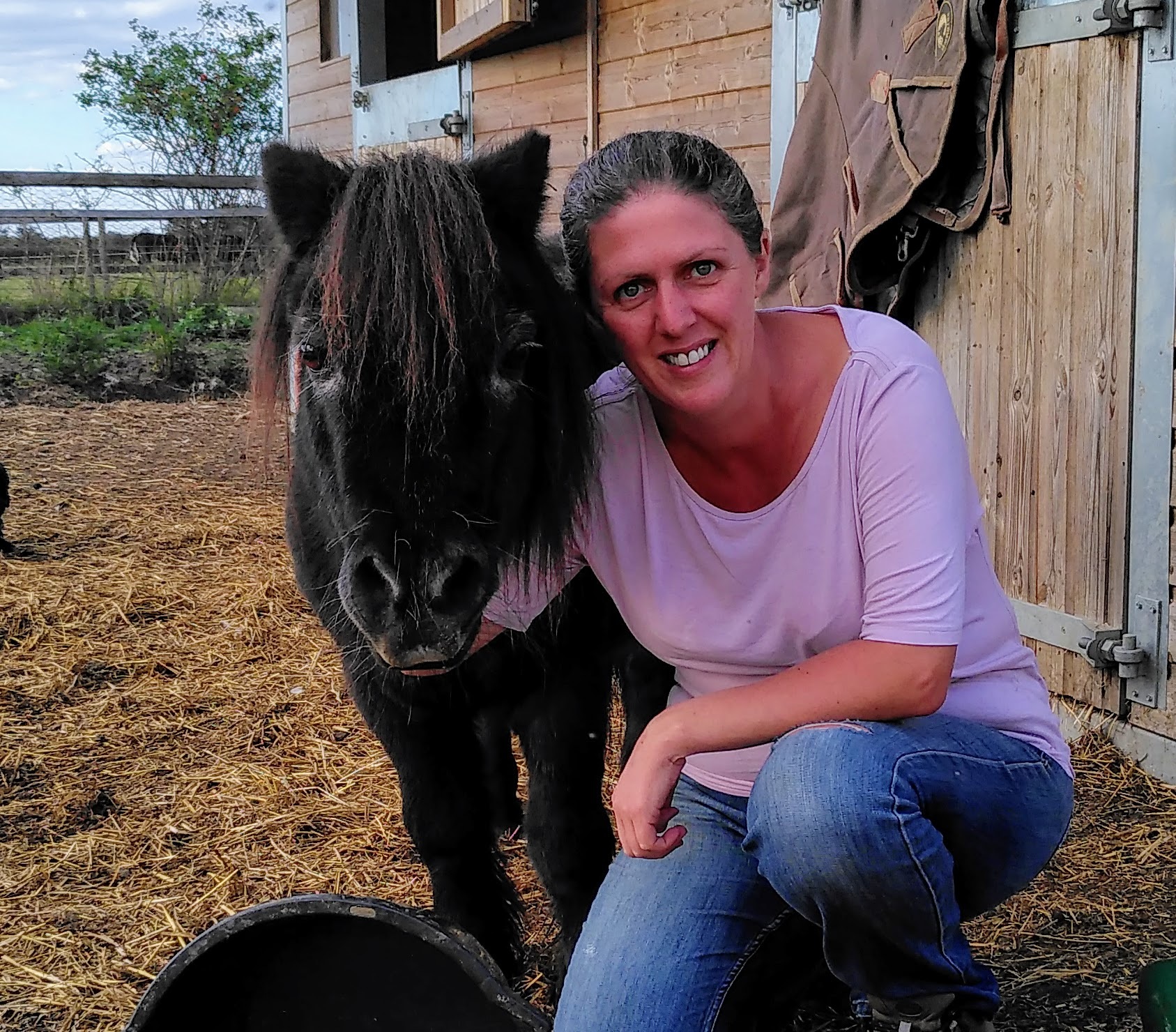Last Updated on February 14, 2022
Horses come in many weird and wonderful patterns of markings, and the overo horse color is one of these! These striking horses are highly sought after for their distinctive splashes of white and colored hair. But what exactly is an overo horse, and how do they get this coloring?
What Is The Overo Horse Color?
The overo horse color is described as ‘colored’ or ‘pinto’ horse – one which has two or more distinctive different colors of hair on its body. The horse will have a solid base coat color and white areas where there is no pigmentation.
The colored hairs on an overo horse can be any of the known base colors. Most commonly, these will be brown or chestnut hairs, but if the horse carries other color modification genes then different base colors can occur.

For example, if a horse carries a dilution gene that lightens the base coat color, you could get an overo with palomino or silver-colored patches.
Confusingly, the sabino and splashed white coat color patterns are classified as overo with the American Paint Horse Association, even though the three patterns are the result of different genetic influences.
Which Breeds Of Horse Have Overo Patterns?
Some breeds of horses are much more likely to have overo coat patterns, while other breeds do not have pinto horses at all.
The most common breeds of horse to have overo coat coloring include the American Quarter Horse and Miniature Horse. The most famous breed of all to exhibit overo patterning is the American Paint Horse. Native Americans highly favored horses with spotted or patterned markings and would select these distinctive horses to breed from.
How Do Overos Get Their Coloring?
An overo horse will have a pair of genes, one from each parent, that determines the original base color. This will be either bay, black, or chestnut. This color may then be influenced by other color modification genes, such as a dilution gene that lightens the color of the coat.
For overo markings to be present, the horse must also carry a specific white spotting pattern genetic modifier. This acts on certain areas of the horse’s coat, removing the pigmentation. These areas will then have white hair, with pink skin.
Horse Color Explored: Over 150 Breeds, Types, and Variations
Pinto horses can be affected by many different white spotting pattern genetic modifiers, and the markings of each type can easily be confused. However, there are some key features of each type of pinto markings that we can use to differentiate between each one.
Click Here To Learn:
What Do Overo Paint Horses Look Like?
One thing is for sure – you will never get two overo Paint horses that look exactly the same! Paint horses, a popular pinto breed of horse, have many horses with overo patterns amongst their population. But how do you tell the difference between an overo horse and other coat color patterns?
There are a few characteristics that most overo horses have in common:
- They will have at least one colored leg, and often all four legs will be colored
- There will be an uninterrupted area of colored hair that runs along the back, from the withers to the base of the tail
- The white areas will be irregular and splattered like someone has splashed white paint over the horse!
- Overo horses commonly have broad white face markings
- The tail of an overo is normally a solid color, and not two-toned

This can help us to tell the difference between an overo horse and a sabino horse, which will normally have four white legs and roan patterning around the white patches. A tobiano will have rounded white patches that cross over the back. The closest color pattern to overo is splashed white patterning, and this coloring is sometimes classified as a type of overo.
What Is A Framed Overo Horse?
The framed overo horse is the only true genetic overo patterning, with all other horses classed as overo occurring as a result of other genetic modifiers. So, although you may see a sabino or splashed white horse in the overo category, they are not true overo patterns.
A framed overo horse color is a highly sought-after type of coat patterning, where the body appears to be framed by dark hair. This appearance is created by dark legs and dark hair along the back, with irregular splashes of white hair on the body and face. The result is a horse that looks like someone has colored in around the edges of the outline!
What Is Lethal White Overo Syndrome?
Unfortunately, the horses with the frame overo pattern are also likely to pass on a genetic defect to their offspring. If both parents carry this defect, there is a 1 in 4 chance that their foal will be born with Lethal White Overo Syndrome (LWO). It is estimated that over 95% of framed overo horses carry this condition.
As the name suggests, foals with LWO will die within a few days of birth. These foals are normally born with a complete lack of pigment in the hair, giving a completely white foal. The genetic defect causes abnormal development of the nervous system and failure of the gastrointestinal tract to function normally.
Most framed overo horses carry one copy of this genetic defect, which leads to a high incidence of deafness in framed overo horses. Breeders of this particular type of overo horse can have them tested for this genetic mutation, to try to reduce the likelihood of producing a foal with LWO.
Summary
So, as we have learned, the overo horse color occurs as a result of a white spotting pattern gene, which removes pigment from patches of hair. It can be easy to mistake overo coloring for other coat patterns, such as tobiano and sabino. The most distinctive feature of the overo horse color is the frame pattern, which gives colored hair around the outline of the horse.
We’d love to hear your thoughts about overo horses! Do you have a Paint horse but are unsure of its exact type of markings? Or perhaps you’re hoping to breed a foal with overo coloring? Leave a comment below and we’ll get back to you!

Kate Chalmers is a qualified veterinary nurse who has specialized in horse care for the vast majority of her career. She has been around horses since she was a child, starting out riding ponies and helping out at the local stables before going on to college to study Horse Care & Management. She has backed and trained many horses during her lifetime and competed in various equestrian sports at different levels.
After Kate qualified as a veterinary nurse, she provided nursing care to the patients of a large equine veterinary hospital for many years. She then went on to teach horse care and veterinary nursing at one of the top colleges in the country. This has led to an in-depth knowledge of the care needs of horses and their various medical ailments, as well as a life-long passion for educating horse owners on how to provide the best possible care for their four-legged friends.
Kate Chalmers BSc (Hons) CVN, Dip AVN (Equine) Dip HE CVN EVN VN A1 PGCE

